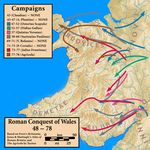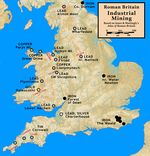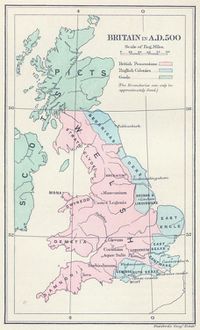تاريخ ويلز
| ثقافة ويلز |
|---|
 |
| التاريخ |
| الشعب |
|
|
The history of Wales begins with the arrival of human beings in the region thousands of years ago. Neanderthals lived in what is now Wales, or Cymru in Welsh, at least 230,000 years ago.[1] Homo sapiens arrived by about 33,000 years ago.[2] However, continuous habitation by modern humans dates from the period after the end of the last ice age around 9000 BC, and Wales has many remains from the Mesolithic, Neolithic, and Bronze Age. During the Iron Age the region, like all of Britain south of the Firth of Forth, was dominated by the Celtic Britons and the British language.[3] The Romans, who began their conquest of Britain in AD 43, first campaigned in what is now northeast Wales in 48 against the Deceangli, and gained total control of the region with their defeat of the Ordovices in 79. The Romans departed from Britain in the 5th century, opening the door for the Anglo-Saxon invasion. Thereafter British language and culture began to splinter, and several distinct groups formed. The Welsh people were the largest of these groups, and are generally discussed independently of the other surviving Brythonic-speaking peoples after the 11th century.[3]

ويلز قبل التاريخ
ويلز في العصر الروماني
بدأ فتح فرونتينوس Frontinus وأگريكولا Agrtcola بلاد ويلز في عام 48 م، وأتما ضمها إلى روما في عام 78 م.

ويلز 525-1066
ويلز بعد الرومان وعصر القديسين: 411–700
ولما انسحب الرومان من بريطانيا استردت ويلز حريتها، وخضعت على كره منه لحكم ملوكها. واحتل غربي ويلز مستعمرون أيرلنديون في القرن الخامس، ثم جاء إليها فيما بعد آلاف من البريطانيين فارين من الأنجليسكسون الذين فتحول جزيرتهم. ووقف زحف الأنجلوسكسون أمام الحواجز القائمة عند حدود ويلز وأطلقوا على الشعب الذي لم يخضعوه اسم ويلهاس Wealhas-"الأجانب". ووجد الأيرلنديون والبريطانيون في ويلز سلالة كلتية من جنسهم، وسرعان ما امتزجت الطوائف الثلاثة وأضحت سمرو Cymru "أبناء وطن واحد". وصار هذا واسمهم كما صار لفظ سمرو Cymru اسم بلادهم وكان هؤلاء الأقوام يقيمون نظامهم الاجتماعي كله على أساس الأسرة والعشيرة شأنهم في هذا شأن معظم الشعوب الكلتية-البريطانيين، والكورنيين Cornish - سكان كورنوول الحالية)، والأيرلنديين، والجيليين Gaeis سكان شمالي إسكتلندة، وقد بلغ من حرصهم على هذا النظام أن يصبحوا يأنفون وجود دولة تضمهم ويرتابون أشد الارتياب في كل شخص أو شعب يجري في عروقه الدم الأجنبي. ولم يكن سخاؤهم وإكرامهم للضيف أقل قوة من نزعتهم القبلية، كما لم تكن شجاعتهم تقل عن عدم خضوعهم للنظام، ولا حياتهم الشاقة وجو بلادهم القارس يقلان عن حبهم للموسيقى والغناء والوفاء للأصدقاء، ولا فقرهم عن عاطفتهم القوية وخيالهم الواسع اللذين جعلا من كل فتاة أميرة ومن نصف الرجال ملوكاً.

ولم يكن يعلو على منزلة الشعراء المنشدين إلا الملوك أنفسهم. ولم يكن هؤلاء الشعراء هم عرّافي شعبهم ومؤرخيه ومستشاري ملوكه فحسب، بل كانوا إلى ذلك شعراؤه. وقد خلد الزمان اسمين اثنين من هؤلاء الشعراء هما تليزن Talesin وأنورين Aneurin؛ وقد عاش كلاهما في القرن السادس الميلادي. وكان هناك مئات غيرهما، وعبرت القصص التي نسجوا بردها القناة الإنجليزية إلى بريطاني، ووصلت في صورة مصقولة إلى فرنسا. وكون هؤلاء المنشدون طبقة من الشعراء الدينيين، لم يكن يسمع لأحد أن ينتمي إليها إلا بعد مران صارم دقيق في معارفه. وكان كل من يريد الدخول في زمرتهم يسمى مابينوج Mabinog، وكان الموضوعات التي يرسها تسمى مابينوجي Mobinogi، ولهذا أطلق اسم مابينوجيون Mabinogion على ما بقي من قصصهم(31). ولا ترجع هذه القصص في صورتها الحالية إلى ما قبل القرن الرابع عشر، ولكن أغلب الظن أنها ترجع إلى ذلك الوقت الذي لم تكن فيه المسيحية قد دخلت بلاد ويلز. وهي قصص بدائية ساذجة ذات نزعة وثنية تشهد بأن الأهلين كانوا من عباد الطبيعة، مليئة بالحيوانات الغربية والحادثات المدهشة، يسودها جو نكد من النفي، والهزيمة، والموت؛ ولكنها ذات مزاج رقيق بعيد كل البعد عن الشهوانية والعنف اللذين نشهدهما في قصص الإدا Eddas الأيسلندية Icelandicن والساجا Sagas خرافات أهل الشمال، والنيبلنجليد Nibelungelied. وقد نشأ في عزلة جبال ويلز أدب خيالي يفيض بالولاء للأمة، والإخلاص فيما بعد لعيسى ومريم. وكان لهذا الأدب شأن في نشأة الفروسية، والقصص العجيبة التي تتحدث عن الملك آرثر Arthur وفرسانه العشاق البواسل الذين أقسموا أن يقضوا على الوثنيين ويقيموا دين المسيح".
ويلز القروسطية المبكرة: 700–1066
see also 11th Century Gwynedd
ودخلت المسيحية ويلز في القرن السادس، وما لبثت بعد دخولها أن افتتحت المدارس في الأديرة والكنائس. وقد جاء الأسقف العالم آسر الذي كان أمين سر الملك ألفرد العظيم وكاتب سيرته من مدينة سانت دافد وكنيسته في مقاطعة بمبروك Pembrokeshire. وتحملت هذه المزارات والمستقرات المسيحية الهجمات الأولى للقراصنة النورمنديين حتى طردهم الملك رودري الأكبر Rhodri (844-878) وأنشأ في الجزيرة أسرة ملكية قوية. ووحَّد الملك هيول الصالح Hywel The Good (910-950) ويلز كلها ووضع لها قانوناً موحداً منظماً. ولاقى جرفيد آب ليولين Grulfydd ab Llywelyn (1309-1063) من النجاح أكثر مما كان يجب أن يلقاه؛ فلما أن هزم مرسية Mercia أقرب القاطعات الإنجليزية إلى ويلز، أعلن عليه هرولد، الذي أصبح فيما بعد ملكاً على إنجلترا، حرباً دفاعية لصد عدوانه، وفتح بلاد ويلز، وضمها إلى بريطانيا (1063).
ويلز والنورمان: 1067–1283

Conquest: from the Statute of Rhuddlan to the Laws in Wales Acts 1283 - 1542
مطلع العصر الحديث
التاريخ المعاصر
انظر أيض
- التاريخ العسكري البريطاني
- تاريخ المملكة المتحدة
- قائمة الحروب الإنگليزية الويلزية
- Red Dragon (magazine)
الهامش
- ^ Davies, J A History of Wales, pp. 3–4.
- ^ http://www.ncbi.nlm.nih.gov/pmc/articles/PMC2752538/
- ^ أ ب Koch, pp. 291–292.
المراجع
- Brut y Tywysogyon or The Chronicle of the Princes. Peniarth Ms. 20 version, ed. and trans. T. Jones [Cardiff, 1952]
- Annales Cambriae. A Translation of Harleian 3859; PRO E.164/1; Cottonian Domitian, A 1; Exeter Cathedral Library MS. 3514 and MS Exchequer DB Neath, PRO E (ISBN 1-899376-81-X)
- Barry Cunliffe (1987) Iron Age communities in Britain' (Routledge & Kegan Paul, 2nd ed) ISBN 0-7100-8725-X
- John Davies, (1994) A History of Wales (Penguin Books) ISBN 0-14-014581-8
- R.R. Davies (1987) Conquest, coexistemce and change: Wales 1063-1415 (Clarendon Press, University of Wales Press) ISBN 0-19-821732-3
- Frere, Sheppard Sunderland (1987), Britannia: A History of Roman Britain (3rd, revised ed.), London: Routledge & Kegan Paul, ISBN 0-7102-1215-1
- Giles, John Allen, ed. (1841), "The Works of Gildas", The Works of Gildas and Nennius, London: James Bohn
- Geraint H. Jenkins (1987) The foundations of modern Wales, 1642-1780 (Clarendon Press, University of Wales Press) ISBN 0-19-821734-X
- Jones, Barri; Mattingly, David (1990), An Atlas of Roman Britain, Cambridge: Blackwell Publishers (published 2007), ISBN 978-1-84217-067-0
- Koch, John T. (2006). Celtic Culture: A Historical Encyclopedia. ABC-CLIO.
{{cite book}}: Cite has empty unknown parameters:|coauthors=and|month=(help) - Laing, Lloyd (1975), "Wales and the Isle of Man", The Archaeology of Late Celtic Britain and Ireland, c. 400-1200 AD, Frome: Book Club Associates (published 1977), pp. 89-119
- Laing, Lloyd; Laing, Jennifer (1990), "The non-Romanized zone of Britannia", Celtic Britain and Ireland, c. 200-800, New York: St. Martin's Press, pp. 96-123, ISBN 0-312-04767-3
- John Edward Lloyd (1911) A history of Wales: from the earliest times to the Edwardian conquest (Longmans, Green & Co.)
- Frances Lynch (1995) Gwynedd (A guide to ancient and historic Wales series) (HMSO) ISBN 0-11-701574-1
- Frances Lynch (1970) Prehistoric Anglesey: the archaeology of the island to the Roman conquest (Anglesey Antiquarian Society)
- Kari Maund (2006) The Welsh kings: warriors, warlords and princes (Tempus) ISBN 0-7524-2973-6
- David Moore (2005) The Welsh wars of independence: c.410-c.1415 (Tempus) ISBN 0-7524-3321-0
- Kenneth O. Morgan (1981) Rebirth of a nation: Wales 1880-1980 (Oxford University Press, University of Wales Press) ISBN 0-19-821736-6
- Remfry, P.M. (2003) A Political Chronology of Wales, 1066 to 1282 (ISBN 1-899376-75-5)
- David Stephenson (1984) The governance of Gwynedd (University of Wales Press) ISBN 0-7083-0850-3
- Glanmor Williams (1987) Recovery, reorientation and reformation: Wales c.1415-1642 (Clarendon Press, University of Wales Press) ISBN 0-19-821733-1
- Gwyn A. Williams (1985) When was Wales?: a history of the Welsh (Black Raven Press) ISBN 0-85159-003-9









